
The Rhacophoridae are a family of frogs that occur in tropical sub-Saharan Africa, South India and Sri Lanka, Japan, northeastern India to eastern China and Taiwan, south through the Philippines and Greater Sundas, and Sulawesi. They are commonly known as shrub frogs, or more ambiguously as "moss frogs" or "bush frogs". Some Rhacophoridae are called "tree frogs". Among the most spectacular members of this family are numerous "flying frogs".

Agalychnis callidryas, commonly known as the red-eyed tree frog, is a species of frog in the subfamily Phyllomedusinae. It is native to forests from Central America to north-western South America. This species is known for its bright coloration, namely its vibrant green body with blue and yellow stripes on the side. It has a white underside, brightly red and orange colored feet, and is named after its distinctive bright red eyes.

Rhacophorus is a genus of frogs in the shrub frog family (Rhacophoridae) and the related Hylidae make up the true tree frogs. They are found in India, Japan, Madagascar, Africa, and Southeast Asia. Over 40 species are currently recognised.

The Malabar gliding frog or Malabar flying frog is a rhacophorid tree frog species found in the Western Ghats of India.

Wallace's flying frog, also known as the gliding frog or the Abah River flying frog, is a moss frog found at least from the Malay Peninsula into western Indonesia, and is present in Borneo and Sumatra. It is named for the biologist, Alfred R. Wallace, who collected the first known specimen.
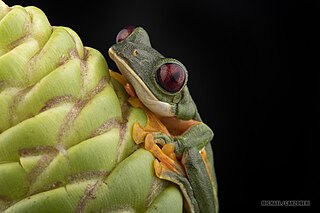
The gliding tree frog is a species of frog in the subfamily Phyllomedusinae. It is found in Colombia, Costa Rica, Ecuador, and Panama. Other common names are the gliding leaf frog, Spurrell's leaf frog, and pink-sided tree frog. The specific name, spurrelli, is in honour of British zoologist Herbert George Flaxman Spurrell.
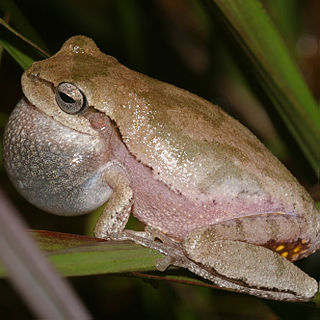
The pine woods tree frog, is a species of frog in the family Hylidae, endemic to the southeastern United States.
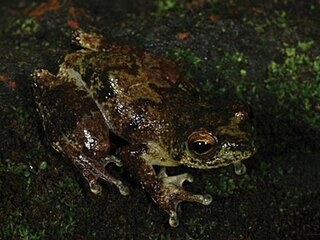
Hyperolius hypsiphonus is a species of frog in the family Hyperoliidae. It is found in southern Cameroon, Gabon, Equatorial Guinea, the western Republic of the Congo, and northwestern Angola. Common name cross-banded egg-guarding frog has been proposed for it.
Zhangixalus omeimontis is a species of frog in the family Rhacophoridae endemic to China. Its common name is Omei whipping frog or Omei treefrog, in reference to its type locality, Mount Emei (Chinese: 峨嵋山; pinyin: Éméi Shān; Wade–Giles: O2-mei2 Shan1) in Sichuan. It is found in southern and central China in Yunnan, Sichuan, Guangxi, Guizhou, Hunan, and Hubei provinces. It is a relatively common frog that inhabits forests, and sometimes farmland. It breeds in still water (pools and ponds). Agriculture and logging are threats to this species.

Zhangixalus arvalis is a species of frog in the family Rhacophoridae. It is endemic to western and southwestern Taiwan and is present in agricultural areas of Chiayi, Yunlin, and Tainan Counties. Common name farmland green treefrog has been coined for it.
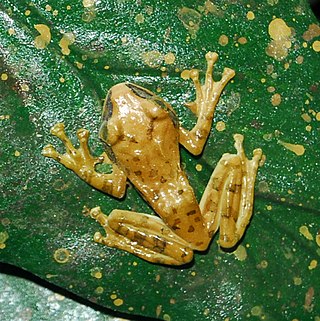
Leptomantis harrissoni, common name Harrisson's flying frog or brown tree frog, is a species of frog in the family Rhacophoridae. It is endemic to northern Borneo.

Feihyla kajau, also known as the Dring's flying frog, white-eared tree frog, and white-eared jelly-nest frog, is a species of frog in the family Rhacophoridae. It is endemic to Borneo and found in all major jurisdictions of the island Kalimantan (Indonesia), Sabah and Sarawak (Malaysia), and Brunei. The specific name kajau is Berawan for "charming".
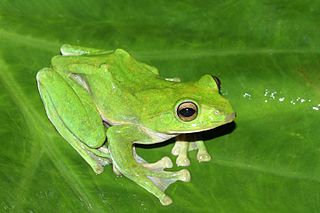
Zhangixalus smaragdinus is a species of frog in the family Rhacophoridae found in southwestern China, north-eastern India, Nepal, western Thailand, and northern Vietnam, and possibly in Bangladesh.

Zhangixalus moltrechti is a species of frog in the family Rhacophoridae. It is endemic to Taiwan, where it has a wide distribution in hilly areas. Common names Moltrecht's green treefrog, Moltrecht's treefrog, Taiwan treefrog, and Nantou flying frog have been coined for it.
The Malayan flying frog is a species of frog in the moss frog family (Rhacophoridae). It is found in Indonesia, Malaysia, and Thailand.

Rhacophorus reinwardtii is a species of frog in the family Rhacophoridae. It is variously known under the common names of black-webbed treefrog, green flying frog, Reinwardt's flying frog, or Reinwardt's treefrog. Before 2006, Rhacophorus reinwardtii and Rhacophorus kio were considered to be the same species. It is not considered threatened by the IUCN.
Leptomantis rufipes is a species of frog in the family Rhacophoridae. It is endemic to Borneo and known from isolated locations in south-central Sarawak and eastern Sabah and central Kalimantan (Indonesia). Common names Malaysian flying frog and red-legged frog have been coined for this species. The specific name rufipes refers to the red webbing of this frog.
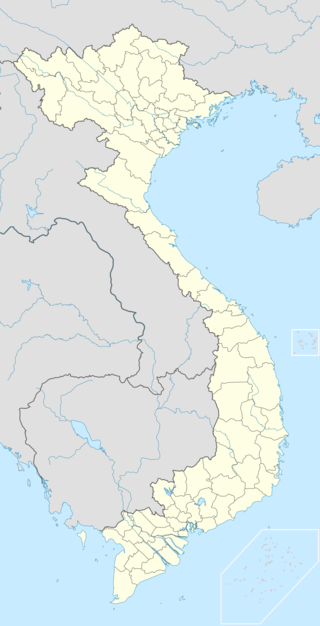
Rhacophorus vampyrus is a medium-sized species of flying frogs endemic to Vietnam. It is found in Southern Vietnam, and is not known to be found in other places globally. It Is in the kingdom Animalia, phylum Chordata, and class Amphibia. Along with this, it is in the order Anura, family Rhacophoridae, and it is the only member of the genus Vampyrus. It is also known as the vampire tree frog or the vampire flying frog because of the presence of a pair of fang-like hooks in the mouth of the tadpoles. Its Vietnamese name is Ếch cây ma cà rồng.
Leptomantis belalongensis is a species of frog in the family Rhacophoridae.

Rhacophorus borneensis is a species of frog in the family Rhacophoridae. This recently (2013) described species is endemic to Malaysian Borneo where it is known from its type locality in the Maliau Basin Conservation Area, Sandakan Division, Sabah as well as from the Batang Ai National Park, Sarawak. Prior to its description, it was included in Rhacophorus reinwardtii. It is said to be "one of the prettiest frogs of Borneo". Common name Borneo flying frog has been coined for it.


















